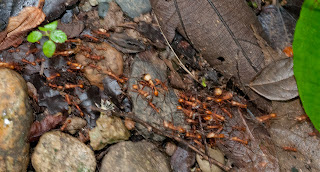 |
| The BioMuseo roofline echoes the graceful curves of the Bridge of the Americas across the Pacific entrance to the Panama Canal. |
George Angehr is a world-class ornithologist, but he's also a world-class museum creator. On the same day he led us a fascinating walk along the birding paradise of Pipeline Road, he also introduced us to his crowning achievement, the soon-to-open BioMuseo in Panama City. Angehr is Curator of Exhibitions for the BioMuseo.
 |
| George Angehr (left) and University of Florida paleontologist Bruce MacFadden. |
BioMuseo is located on the Amador Causeway at the Pacific Ocean entrance to the Panama Canal. The building was designed by world-renowned architect Frank Gehry. It's colorful roof is visible for miles and is said to mimic the plumage of the country's many tropical birds.
The museum is divided into eight galleries that explain the origin of the Isthmus of Panama and its huge impact on the planet's biodiversity. They are:
Gallery of Biodiversity -- A ramp will welcome visitors to the world of natural science and the explosion of life in Panama.
Panamarama -- A projection space on three levels and 10 screens immerses the visitor in an audiovisual presentation of the natural wonders of Panama's ecosystems.
Building the Bridge -- The tectonic forces inside the Earth that formed the isthmus are represented by three 14-foot-high sculptures.
When Worlds Collide -- When the isthmus was closed, there was a great exchange of species between North and South America. A stampede of animal sculptures illustrate the movement of 72 species north and south across the isthmus beginning nearly 3 million years.
Human Path -- In a partially open space, 16 columns tell the story of humans on the isthmus, from prehistoric times to the present.
Oceans Divided -- When Panama emerged, two very different oceans were formed, changing lives all over the Earth. Two multi-story aquariums will illustrate how the Pacific and the Caribbean evolved separately because of the isthmus.
The Living Web -- A huge sculpture representing a fig tree will illustrate how plants and animals are interconnected.
Panama is the Museum -- The land around the museum will be a botanical park which will link the museum with the rest of the country.
The first five galleries are schedule to open in January 2014.
The University of Florida has been a major partner in the development of the exhibits for the BioMuseo. UF's Panama Canal Project PIRE has been collaborating with BioMuseo for the past three years, providing them with fossil casts for display in some of the galleries. The Florida Museum of Natural History is also providing a giant Megalodon shark jaw to BioMuseo on long-term loan.




















